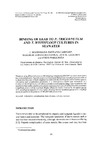Identificador persistente para citar o vincular este elemento:
https://accedacris.ulpgc.es/jspui/handle/10553/1648
| Título: | Binding of lead to P. Tricornutum and T. Weissflogii cultures in seawater | Autores/as: | Santana-Casiano, J. M. Gonzalez-Davila, M. Laglera Baquer, Luis Miguel Perez-Pena, J. |
Clasificación UNESCO: | Investigación | Palabras clave: | Adsorción Diatomeas Agua de mar Análisis |
Fecha de publicación: | 1999 | Publicación seriada: | Toxicological and Environmental Chemistry | Resumen: | Titrations using differential pulse anodic stripping voltammetry (DPASV) to detect electroactive lead were carried out in Phaeodactylum tricornutum and Thalassiosira weissflogii seawater cultures to determine the extent of lead complexation with both dissolved ligands and cell surface groups. Adsorption and complexation parameters in a heterogeneous model were determined as a function of pH, temperature, and salinity and cell concentration by using a new iterative method. Lead forms high stable complexes in seawater and organically complexed lead fraction constitutes a significant portion of the total lead. Higher affinity for lead is observed by the surface groups of T. weissflogii in respect to P. tricornutum showing that the functional groups of T. weissflogii are more specific in the presence of 100 nM Cu(II) in solution. | URI: | https://accedacris.ulpgc.es/handle/10553/1648 | ISSN: | 0277-2248 | DOI: | 10.1080/02772249909358859 | Fuente: | Toxicological and Environmental Chemistry[ISSN 0277-2248],v. 73, p. 191-206 |
| Colección: | Artículos |
Citas SCOPUSTM
2
actualizado el 08-jun-2025
Visitas
50
actualizado el 10-ene-2026
Descargas
113
actualizado el 10-ene-2026
Google ScholarTM
Verifica
Altmetric
Comparte
Exporta metadatos
Los elementos en ULPGC accedaCRIS están protegidos por derechos de autor con todos los derechos reservados, a menos que se indique lo contrario.
